
by Les Harrison | May 23, 2018
There is something to be said for being a longtime resident. While it does limit ones outlook from a global perspective, it promotes focus on perfecting applicable traits which are close to home.
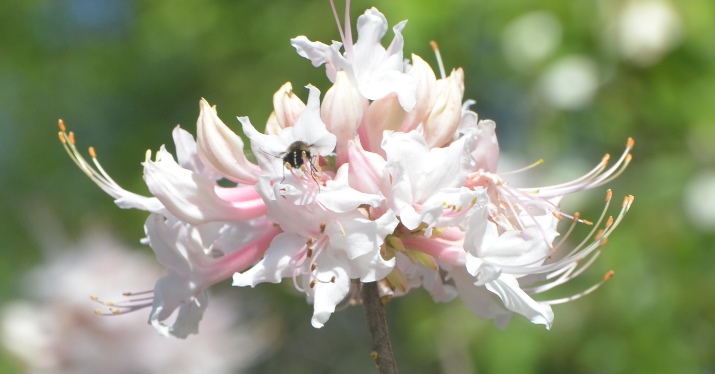
Azalea and bug: Wild Piedmont Azaleas (Rhododendron canescens) and a bumble bee.
The unique, and very pleasant, environment of north Florida is an excellent example of near perfection on a localized basis. The weather (within reason), the fauna and the flora are tailored to a superior quality of life, especially the spring blooming native plants.
The human residents of the panhandle can easily see this in a native plant which blooms in the spring. Wild azaleas make random appearances, but their cultivated cousins from Asia are now the province of retail establishments.
Azaleas are member of the Rhododendron genus which includes flowering shrubs of the same name which grow in more northern latitudes. Their popularity as flowering perennials has led to the development of more than 10,000 cultivars worldwide which please almost every taste for a profuse and showy burst of color.
These plants have species native to southwest Europe, Asia, and North America. They are believed to date back 70 million years and have an ancestor in common with blueberries and pieris.
Many of the azaleas which grace the yards and gardens in the southeast are traced back to east Asian stock. These cultivars had been grown for millennia, but reached Europe in the early 17th Century when wealthy estate owners were seeking a new and unique look to their landscapes.
When azaleas arrived in America there were 26 different native azaleas already growing here. At least four of these grow naturally in Florida and can be presently seen in natural settings, as well as, managed landscapes.
Like the long cultivated Asian varieties, the azaleas native to Florida prefer acidic soils and filtered light. The can be found in forested areas and near streams or rivers.
The native azaleas are rather scraggly and upright when very young, but will spread out and fill in as they mature. The large, dark green leaves bend the branches gently to form a cascading appearance down to the ground.
A single specimen in a formal landscape should be allowed at least four to five feet of spread to develop into its natural form. These plants are very sensitive to dry soil, but the soil should drain freely of excessive moisture.
A thick mulch of three inches deep is recommended to help ensure adequate root growth when cultivated out of their natural environment. Roots are located in the top several inches, even in well-drained sandy soils, so adequate mulching is critical to success.
Pruning of these natives is seldom necessary except to control shoots extending above the normally mounded shape. Azaleas bloom on the previous year’s growth so any pruning should be done after flowering, but before July.
Mass azalea plantings add a stark color contrast to any landscape. The green background of March and April with clusters of boldly bright blossoms is a striking sight.
The wild azaleas add an enduring continuity to the ever-changing landscape in contemporary life. Some things should never change, especially in comfortable north Florida.
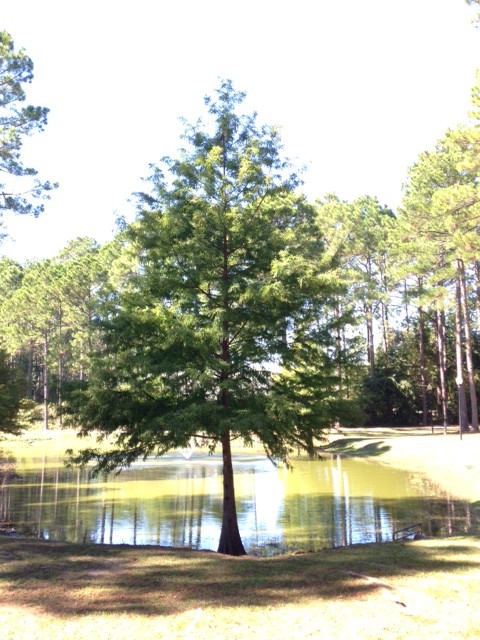
by Julie McConnell | Jun 2, 2015
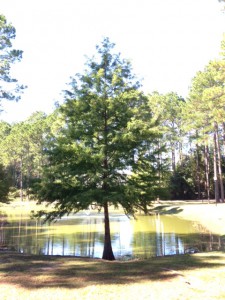
Bald cypress growing at the edge of a pond. Photo: Julie McConnell, UF/IFAS
Considering planting a tree in your landscape, but not sure what will do well?
Baldcypress, Taxodium distichum, is one tree you should consider for your Florida landscape. This deciduous conifer is native to North America and is suited to a wide variety of situations, even difficult ones!
Baldcypress is found naturally along stream banks and in swampy areas, but also performs well in dry situations once established. Not many trees can tolerate standing water or flooding situations, but baldcypress is well adapted to these tough spots. In areas that flood or remain wet the tree will form “knees” that project out of the ground and add a beautiful feature – just don’t plan to mow in areas where these develop. Not restricted to wet areas, baldcypress also performs well as a street tree or in limited root zone situations such as parking lot islands.
This tough tree has a soft, delicate leaf texture and interesting globular cones that start out green then turn brown as they mature. The foliage is light green through the spring and summer then turns a coppery gold before the needles fall in the winter. The trunk has a reddish color that is also attractive and will grow branches low to the ground, but can easily be maintained with a clear trunk in a street tree form.
Baldcypress will grow in full sun to part shade and is adapted to all soil types except highly alkaline (over 7.5 pH). Sand, loam, clay, or muck can all sustain this native tree. Few pests bother baldcypress, but it can be affected by bagworms and mites. Mature size can be in excess of 100 feet, but trees typically grow 60-80 feet tall in Florida.
For more information:
Taxodium distichum: Baldcypress
by Taylor Vandiver | Jul 1, 2014
The summertime often reminds us of our uninhibited spirit. With Independence Day not far off, Floridians will be celebrating the freedom of our nation while battling the oppressive climate you can’t seem to escape this time of year. As we approach the apex of heat and humidity here in Florida, we would do well to remember the tenacity of our native wildflowers and their “spirited” survival of Florida’s extreme conditions.
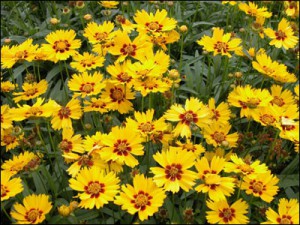
Coreopsis flowers. Photo courtesy UF/IFAS.
Historically, Florida’s landscape was alive with color throughout the seasons. Through urbanization and cultivation we’ve lost a large part of that legacy; however, we can reestablish some of Florida’s colorful past in our own yards and neighborhoods.
In order to ensure successful planting of wildflowers it is important to properly select and prepare your site. You will want to choose a sunny-well drained area and cut any existing vegetation to the ground. It may be beneficial to put down sheets of cardboard to smother what’s left of the vegetation. This is best done in the summer in advance of fall planting.
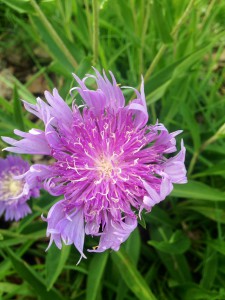
Stokes’ Aster in bloom.
Planting is best done late August to early September in North Florida. Soil-to-seed contact is critical so 1 day before seeding, or just prior to seeding, firmer soils need to be lightly scratched with a rake. Sandy soils might have to be made more firm to ensure that seed do not sink too deep. Broadcast the wildflower seeds at the recommended rate then press them into the soil by walking around on the planting site.
Wildflower seeds require adequate moisture during germination. After planting irrigate the site with about 1/4 to 1/2 inch of water daily for the first few weeks. After that, irrigate with about 1/2 inch water only if the wildflowers show signs of drought stress. Once established though, the meadow needs very little, if any, irrigation. Fertilizers should be avoided altogether as they promote the growth of aggressive weeds. Many of Florida’s native wildflower species are adapted to and perform well in soils with low fertility. Your wildflowers will re-send themselves if given the opportunity so wait until seed have matured before deadheading or mowing. Cut no lower than six to eight inches to avoid damaging the crowns of grasses and wildflowers.
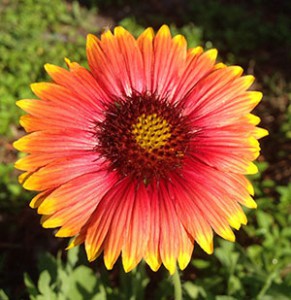
Native Gaillardia. Photo courtesy UF/IFAS.
To successfully cultivate a wildflower meadow in your home landscape, it’s helpful to select plants with the qualities to fit the conditions at your site. Also, consider blooming dates of flowers in order to provide color and interest for your landscape spring through fall. While not always possible, it’s best to purchase seeds and plants known to be Florida ecotypes. Consult with local nurseries and garden centers for more information on plant and seed availability and seeding rates. You can always contact your local Extension Office for more information. Other good sources of information are the Wildflower Seed And Plant Growers Association, Inc. (www.floridawildflowers.com); Association of Florida Native Nurseries (www.afnn.org); and the Florida Wildflower Foundation (www.floridawildflowerfoundation.org).
Growing wildflowers can restore a special sense of natural history close to home. So if you are looking for an “explosion” of color that will stand the test of time, Florida’s native wildflowers will not disappoint.
by Julie McConnell | Oct 14, 2013
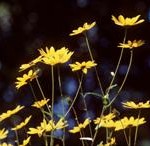
Swamp Sunflower Photo credit: UF/IFAS Milt Putnam
Fall Blooming Native Wildflowers
Drive along any highway or rural road at this time of year and chances are some color will catch your eye; not so much in the tree tops, but in ditches and right of ways.
Although yellow seems to be the predominant color in the fall, pay attention and you may spot reds, oranges, and even some blues in the wildflower pallet.
Examples of wildflowers that bloom late summer to early fall in the Panhandle:
• Bluestar (Amsonia ciliate), blue flowers, 1-3’
• Butterfly Weed (Asclepias tuberosa), orange flowers, 1-3’
• Lanceleaf Coreopsis (Coreopsis lanceolata), yellow flowers, 1-2’
• Leavenworth’s Coreopsis (Coreopsis leavenworthii), yellow flowers, 1-3’
• Swamp Sunflower (Helianthus angustifolia), yellow flowers, 2-6’
• Rayless Sunflower (Helianthus radula), purple flower, 2-3’
• Cardinal Flower (Lobelia cardinalis), red flowers 2-4’
• Lyreleaf Sage (Salvia lyrata), purple flowers, 1-2’
• Goldenrods (Solidago spp.), yellow flowers, 1.5-6’
• Tall Ironweed (Veronia angustifolia), purple flowers, 2-4’
To learn more about these and many other wildflowers read EDIS Publication “Common Native Wildflowers of North Florida.”








